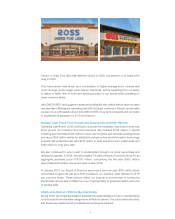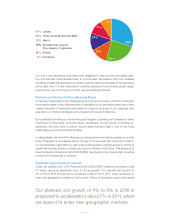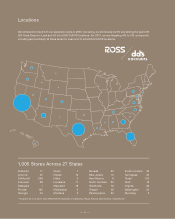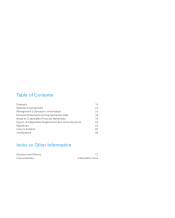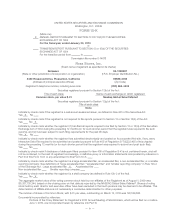Ross 2009 Annual Report Download - page 13
Download and view the complete annual report
Please find page 13 of the 2009 Ross annual report below. You can navigate through the pages in the report by either clicking on the pages listed below, or by using the keyword search tool below to find specific information within the annual report.— 11 —
We have established merchandise assortments that we believe are attractive to our target customers. Although we offer fewer
classifications of merchandise than most department stores, we generally offer a large selection of brand names within each
classification with a wide assortment of vendors, labels, prices, colors, styles, and fabrics within each size or item. The mix
of comparable store sales by department in fiscal 2009 was approximately as follows: Ladies 30%, Home Accents and Bed
and Bath 24%, Men’s 13%, Accessories, Lingerie, Fine Jewelry, and Fragrances 13%, Shoes 11%, and Children’s 9%. Our
merchandise offerings also include product categories such as small furniture and furniture accents, educational toys and
games, luggage, gourmet food and cookware, watches, sporting goods and, in select Ross stores, fine jewelry.
Purchasing. We have a combined network of approximately 7,700 merchandise vendors and manufacturers for both Ross and
dd’s DISCOUNTS and believe we have adequate sources of first-quality merchandise to meet our requirements. We purchase
the vast majority of our merchandise directly from manufacturers, and we have not experienced any difficulty in obtaining
sufficient merchandise inventory.
We believe that our ability to effectively execute certain off-price buying strategies is a key factor in our success. Our
buyers use a number of methods that enable us to offer our customers brand-name and designer merchandise at strong
everyday discounts relative to department and specialty stores for Ross and moderate department and discount stores for
dd’s DISCOUNTS. By purchasing later in the merchandise buying cycle than department, specialty, and discount stores we are
able to take advantage of imbalances between retailers’ demand for products and manufacturers’ supply of those products.
Unlike most department and specialty stores, we typically do not require that manufacturers provide promotional allowances,
co-op advertising allowances, return privileges, split shipments, drop shipments to stores, or delayed deliveries of merchandise.
For most orders, only one delivery is made to one of our four distribution centers. These flexible requirements further enable our
buyers to obtain significant discounts on in-season purchases.
The majority of the apparel and apparel-related merchandise that we offer in all of our stores is acquired through opportunistic
purchases created by manufacturer overruns and canceled orders both during and at the end of a season. These buys are
referred to as “close-out” and “packaway” purchases. Close-outs can be shipped to stores in-season, allowing us to get
in-season goods into our stores at lower prices. Packaway merchandise is purchased with the intent that it will be stored in
our warehouses until a later date, which may even be the beginning of the same selling season in the following year. Packaway
purchases are an effective method of increasing the percentage of prestige and national brands at competitive savings within
our merchandise assortments. Packaway merchandise is mainly fashion basics and, therefore, not usually affected by shifts in
fashion trends.
In fiscal 2009, we continued our emphasis on this important sourcing strategy in response to compelling opportunities
available in the marketplace. Packaway accounted for approximately 38% of total inventories as of January 30, 2010 and
January 31, 2009. We believe the strong discounts we are able to offer on packaway merchandise are one of the key drivers
of our business results.
We continued to roll out additional information system enhancements and process changes to improve our merchandising
capabilities. These new tools are designed to strengthen our ability to plan, buy, and allocate at a more local versus regional
level. We completed the chain-wide rollout to all merchandise categories for Ross in fiscal 2009, which was earlier than
planned. The long-term objective of these investments is to fine tune our merchandise offerings to address more localized
customer preferences and thereby gradually increase sales productivity and gross profit margins in both newer and existing
regions and markets.




